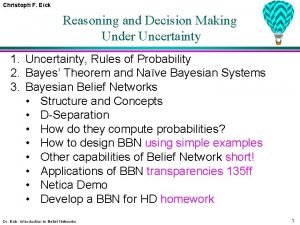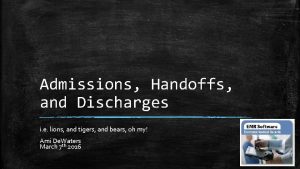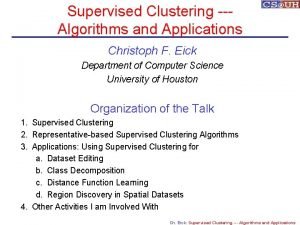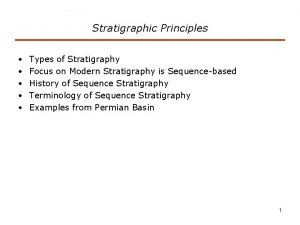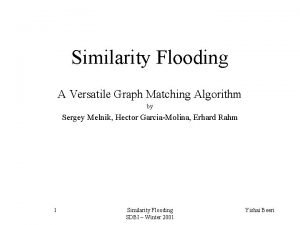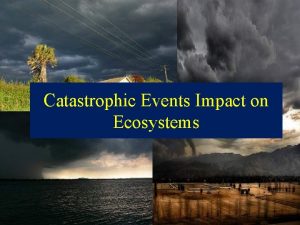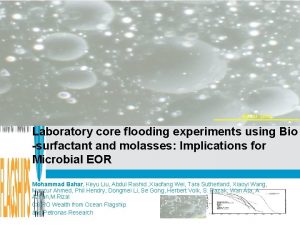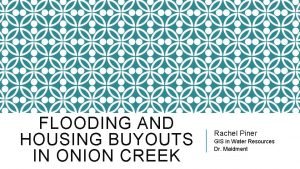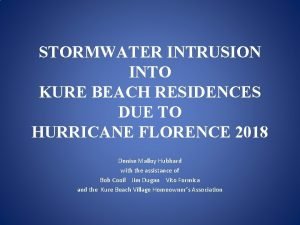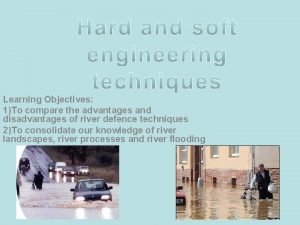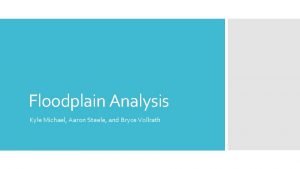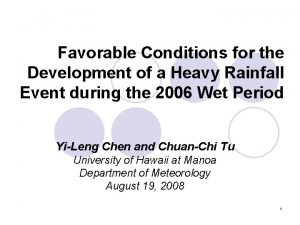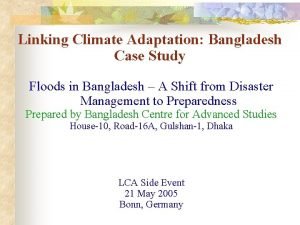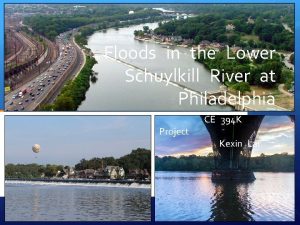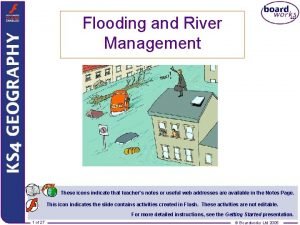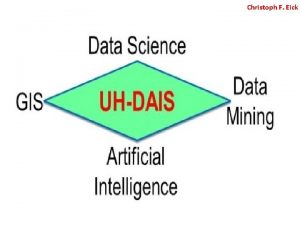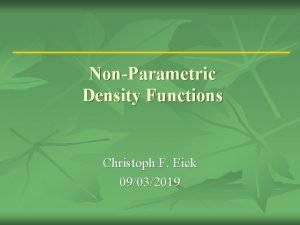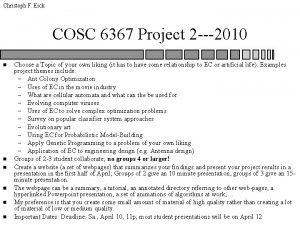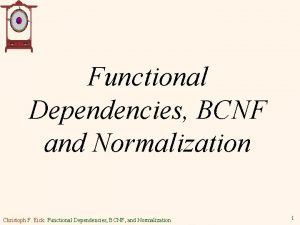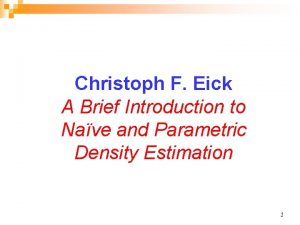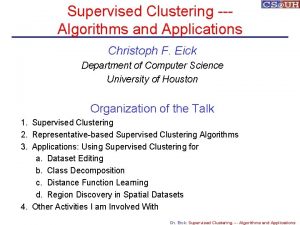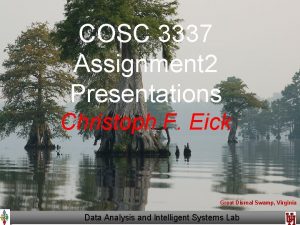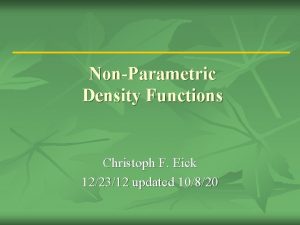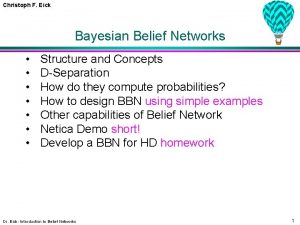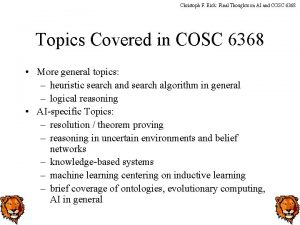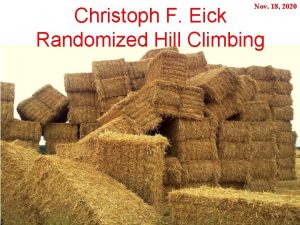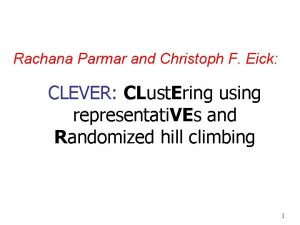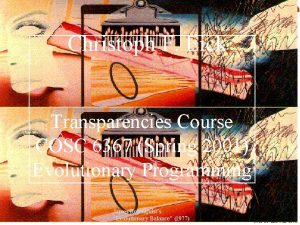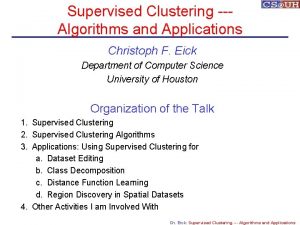Flooding Research Initiatives Christoph F Eick Great Dismal
























- Slides: 24

Flooding Research Initiatives Christoph F. Eick Great Dismal Swamp, Virginia Data Analysis and Intelligent Department of Computer Science. Systems Lab

1. Arturo Leon Welcome to the research group of Dr. Arturo S. Leon. Our main research interests are on the areas of hydraulic transients (single- and two-phase flows), resilient approaches to flood control, optimal reservoir operation under uncertainty, sustainable stormwater management and modeling, real-time control of complex hydraulic systems, computational hydraulics (CFD ) and physical modeling of hydraulic structures. Department of Computer Science

2. Predicting, Mapping, and Dealing with Flooding Current Research Tasks: 1. Predict Water Levels 2. Flood Risk Mapping 3. Routing in the Presence of High Water People: Christariny Hutapea, Yue Cao, Romita Banerjee, Khadija Khaldi, Anusha Nemilidinne Priyal Kulkarni and Yongli Zhang. http: //www. harriscountyfws. org/ Department of Computer Science UH-DAIS

A Generic DAG-Based Chaining Approach for WLP R(t), R(t-1), …(Rainfall) W(t), W(t-1), …(Water-level) V(t), V(t-1) (Stream Velocity) S(t), S(t-1)… (Soil Moisture) D(t), D(t-1), …(Discharge) Raw Data DAG of Measuring Points Prediction Scenario Mapping Tool Model Execution Framework Data Sets (one for each Measuring Point) Single Target Prediction System f 1 f 3 f 2 DAG off the shelf f 4 currently under development at UH uses Models (one for each Measuring Point)

Training Challenges for Data Driven WLP Approaches § Need to extract historic water level, discharge(? ? https: //water. usgs. gov/edu/streamflow 2. html ) and rainfall data from USGS National Water Information System, Austin Flood Early Warning System, Hydro. Met, HCFCD EWS, Seattle… § Extract historical soil moisture data from NASA NLADS https: //ldas. gsfc. nasa. gov/nldas/ Creating stream velocity data: use USGS, use the National Water Model predictions to create velocity data in training sets, …? !? Remark: Creating a Challenging Water Level Prediction Benchmark to Test and Compare Various WLP Systems is important! W 3, t=f 3( W 1, t, W 3, t-1, R 3, t, V 3, t-1, S 3, t-1) Prediction Scenario f 1 f 3 f 2 f 4 DAG Department of Computer Science UH-DAIS

Using Learned Models to Make Water Level Predictions § Rain Forecast has to be fed into the system; we do not plan to develop a rain forecasting system… § Soil Moisture has also be fed into the system or alternatively be predicted; there might be some useful work at NASA SMAP https: //smap. jpl. nasa. gov/mission/description/ § Stream Velocity has also be fed into the system or alternatively predicted § Those data have to be available in real-time or “almost realtime” W 3, t=f 3( W 1, t, W 3, t-1, R 3, t, V 3, t-1, S 3, t-1) Prediction Scenario f 1 f 3 f 2 f 4 DAG Department of Computer Science UH-DAIS

Model Fusion and Meta Learning USGS Models (http: //water. usgs. gov/nrp/software. php) What model works best under which circumstances? Model Fusion and Meta. Learning Data-driven Models for the Watersheds NOAA Models (http: //water. noaa. gov/about/nwm ) Our Project Department of Computer Science UH-DAIS

3. NSF Planning Proposal (Eick&Peres) Design of a Generic Water Level Prediction and Flood Early Warning System Overview: Flood is the most hazardous natural disasters in the world …Consequently, many US cities developed sensor based early warning systems that collect water level and other data in real-time…One major research goal of the proposal is the development of a flood early warning system that provides the capability to predict future water levels. To accomplish this goal novel datadriven water level prediction techniques that interpolate the past into the future will be investigated, compared and fused with classical hydrological models. However, for a flood early warning system to be useful, it is critical to ensure that the needs of the stakeholders interacting with such a system are considered in the system design. Investigating the behavioral aspects and human-computer interaction aspects of stakeholders using flood warning systems is the second major research goal of this proposal. To accomplish these two goals, we plan to assemble a strong research team that consists of surface hydrologists and members of organizations, such as NOAA, that develop water level prediction models and representatives of flood control districts and emergency management departments of several US cities. Department of Computer Science UH-DAIS

4. Automated Flood Risk Mapping Austin Fire First Responder Vehicle Flood Risk Map Creating these maps is a lot work and requires GIS and hydrology knowledge. Department of Computer Science

Flood Risk Mapping Wharton County, Texas http: //abc 13. com/news/wharton-mayor-calls-for-voluntary-evacuation/744958/ Wharton County April 2016 Flooding Department of Computer Science Wharton County Fire Chief

Height Above Nearest Drainage (HAND) developed by: UT Austin Center for Research in Water Resources HAND Flood Normal Department of Computer Science

Texas Hand Map (7, 600, 000 Address Points) Department of Computer Science

Hand-based Flood Risk Assessment Austin Metropolitan Area (Williamson, Travis, and Hays County) Department of Computer Science

Automated Flood Risk Mapping Department of Computer Science

FEMA Flood Maps Department of Computer Science

5. Polygon Analysis for Better Flood Risk Mapping Knowledge of Flooded Areas from Past Floods FEMA Flood Risk Zones DEM (Digital Elevation Maps) Find Correspondence Find Agreement, Combine, Validate Austin Fire First Response Vehicle Flood Risk Map Department of Computer Science Hand Value Multi-Contour Maps HEC-RAS Generated Polygons UH-DAIS

FEMA and Austin Fire Maps Department of Computer Science

Analyzing Different Polygonal Data that Describe Levels of Flood Risks Benefits and Objectives: § Flood Risk Map Validation § Flood Risk Map Standardization § Creating Flood Risk Maps Automatically § Mapping Agreement/Disagreement with Respect to Different Flood Risk Models. § Understanding the weakness/strength of particular methods § Creating “combined” flood risk models that take knowledge from different sources (e. g. HEC-RAS generated, elevation maps, knowledge of past flooding) § Dynamic Flood Risk Maps that adapt their appearance based on contextual information Department of Computer Science UH-DAIS

UH-DAIS Research to Address these Problems 1. Computational Methods to create flood risk maps from pointwise or grid-based flood risk assessment (e. g. hand value maps or elevation maps). We investigated in the past and are currently investigating: § graph-based approaches § Continuous function based approaches 2. Similarity Assessment Methods to find Agreement Between Different Polygonal Flood Risk Maps 3. Correspondence Contouring Methods (e. g. find a sequence of elevation thresholds so that the obtained contour polygons best match with FEMA flood risk zones) 4. Computing Agreement Maps between Different Methods 5. Creating “better” flood risk maps by combining information from different sources. Department of Computer Science UH-DAIS

6. Expert Systems for Flood Risk Mapping Local Information (Watersheds, Elevation maps, …) User (Not an expert in GIS & hydrology) Expert System creates Flood Risk Mapping Knowledge Base Department of Computer Science

7. Helping First Responders with DS/GIS/HCI to Deal with Flooding § How do First Responders use Flood Risk Maps? How is feedback from First Responders used to Enhance Flood Risk Maps? § What other information is important to communicate to first responders when dealing with flood events? What is the current approach communicating this information? § What role does GIS contribute play in helping first responders do deal with flood events? § Human Computer Interaction (HCI): How to present flooding related information to first responders? What formats are the best to display information? What are the best communication strategies for first responders? § Can crowd sourcing help to alleviate the effects of flooding? If yes, what should it be used for? § What is needed in the future? What should future research focus on the enhance the ‘state of the art’ of dealing with flooding? § What about planning procedure to deal with flooding events? Department of Computer Science UH-DAIS

8. Flooding People: (Potential) Collaborators S. Camille Peres (Texas A&M Univesity)---Behavioral and HCI aspects of flood warning systems: https: //sph. tamhsc. edu/eoh/faculty/peres. html Jian Chen (University of Louisiana at Lafayette)---Hydrology models and their use for flood prediction, GIS: https: //www. researchgate. net/profile/Jian_Chen 20 Marian Muste (University of Iowa)---instrumentation, maybe visualization and web-platforms for early warning systems: http: //www. iihr. uiowa. edu/mmuste/ Bruce Race (College of Architecture, University of Houston)---community and infra-stucture resilience; architectural and policy aspects of flooding: https: //aiahouston. org/v/member-detail/Bruce-Race/slak 7/ David Maidment (Director, UT Center for Research for in Water Resources): National Water Model, Flood Inundation Mapping, Flood Risk Assessment, … http: //www. ce. utexas. edu/prof/maidment/gishydro/maidment. html David Arctur ((Research Scientist, UT Center for Research for in Water Resources) Time Whiteaker (Research Scientist, UT Center for Research for in Water Resources) Harry Evans (Former Austin Fire Chief, UT Center for Research for in Water Resources) Xing Zheng (Ph. D Student, UT Center for Research for in Water Resources) Christine Thies (Austin Fire Department): Head of the GIS Department, Liaison to Fire Fighters Jorge Urquidi (Austin Flood Early Warning System): Flood Risk Map Generation Maybe, Will Merrell (Houston-Galveston Area Research Council) Will. Merrell@h-gac. com: Environmental Planner, planning aspects of flooding Department of Computer Science UH-DAIS

More Flooding People (Houston-based) Gary Bezemek is a Precinct Coordinator for the Harris County Flood Control District. Mr. Bezemek has been with the Flood Control District since April 2004, and is a professional engineer licensed to practice engineering in the state of Texas. In his current capacity, Mr. Bezemek is the liaison between Precinct 4 and the Flood Control District. Prior to assuming the Precinct Coordinator roll, Mr. Bezemek was the program manager for the Flood Control District’s Watershed Master Plan Studies program. Prior to coming to the District, Mr. Bezemek worked for more than 9 years in the private sector as a consulting engineer for two local Harris County engineering firms. Mr. Bezemek holds a Bachelor of Science in Civil Engineering degree from the University of Texas and a Master of Science in Civil Engineering degree from Stanford University. Michael F. Bloom, Manager, Sustainability Practice at R. G. Miller Engineers, Inc. , Steering Committee Member at Houston Land Water Sustainability Forum, . . . before: Chair, Watershed Management Committee at Water Environment Association of Texas, Instructor for Advanced Sustainable Design (CEVE 323 -523). . . Education: Drexel University, Syracuse University Specialty: Sustainability consultant who helps public infrastructure and land development clients reduce detention requirements, reduce drainage. . . Bret Jordan, Ph. D has 10 years of experience in hydrology, fluvial geomorphology, open channel hydraulics, storm water management, erosion control, sediment transport and stream restoration design in the academic and private consulting sectors. He has worked on over 30 different river systems ranging from steep mountain headwater streams to low gradient sand bed streams and coastal marshlands in the Pacific Northwest, Inter-Mountain West, Southeast and Gulf Coast regions. These projects have ranged from watershed scale analysis of sediment and nutrient transport, reach scale stream and coastal marshland restoration designs and site specific analysis of hydraulic structures. Brett has also has taught graduate level courses in the Civil Engineering Department at Colorado State University and short courses to government agencies focusing on field data collection and analysis of river systems. brett@hydrogeodesigns. com Phil Bedient (Rice University; http: //bedient. rice. edu/ ) Department of Computer Science UH-DAIS

More Out of Town Flooding People Edward Clark (Director of the NOAA National Water Center’s (NWC) Geo-Intelligence Division NWC). The NWC Geo-Intelligence Division is responsible for providing centralized and consistent data services, geospatial analyses, and cartographic expertise to support science and engineering development, systems implementation, and water resources operations at local, regional, national, and global scales. GID collaborates with partners and supports NWC and field operations, external partners, customers and stakeholders, and corporate knowledge management. Prior to joining the NWC, Ed has served in NWS Headquarters as the National Flash Flood Service Leader in the Analyze, Forecast, and Support Office. Prior to his tenure at NWS HQ, Ed had over seven years of experience as an operational hydrologic forecaster, working as a Senior Hydrologist at the Colorado Basin River Forecast Center in Salt Lake City. Ed’s background is in civil engineering with an emphasis on water resources and hydrology. Edward. Clark@noaa. gov Marian Muste (Research Engineer, IIHR Hydroscience and Engineering (http: //www. iihr. uiowa. edu/about/ ); Additional Titles: Researcher, Iowa Flood Center, Center for Global and Regional Environmental Research) My most recent research area is hydroinformatics (a. k. a. cyber infratructure for water-related investigations over large-scales). Special efforts are focused on modern field data acquisition systems, internet-based geodatabases and ancillary cyber-tools for harvesting, storing, handling data, and conduct of uncertainty, risk, and reliability analyses (http: //hydroinfo. uiowa. edu). The practical goals of this research are related with development of eco-hydrologic watershed-scale data and information interactive repositories (http: //iowadis. org). The observatories are virtual (digital) environments that aggregate large-scale datasets acquired by sensor networks with results of numerical simulations for conduct of research, education, and supporting the decision making process. These cyberplatforms enable transformative processes for extraction of data and knowledge from the raw data garnered from observatory information and numerical simulations for the benefit of science, practice and society. IIHR—Hydroscience & Engineering 302 E C. Maxwell Stanley Hydraulics Laboratory, Iowa City, IA 52242 -1585, U. S. A. Phone: (319) 384 0624 Fax: (319) 335 5238 Email: marian-muste@uiowa. edu; Department of Computer Science UH-DAIS
 Christoph eick
Christoph eick Ceick
Ceick Adcvandiml
Adcvandiml Balcony scene romeo and juliet quotes
Balcony scene romeo and juliet quotes Lugubriously
Lugubriously Eick wilson
Eick wilson Maximum flooding surface
Maximum flooding surface Similarity flooding
Similarity flooding Flooding therapy
Flooding therapy Tornado impact on ecosystem
Tornado impact on ecosystem Acceleration behavioral therapies
Acceleration behavioral therapies Emotional flooding
Emotional flooding Core flooding experiment
Core flooding experiment Onion creek flooding
Onion creek flooding Vpc vs lacp
Vpc vs lacp Kure beach flooding
Kure beach flooding Flood warning systems advantages and disadvantages
Flood warning systems advantages and disadvantages Michael
Michael Kahala mall flooding
Kahala mall flooding Rush to muster station with a
Rush to muster station with a Key west flooding
Key west flooding Flooding in bangladesh case study
Flooding in bangladesh case study Schuylkill river flooding
Schuylkill river flooding Flooding icons
Flooding icons Titanic starboard side
Titanic starboard side
